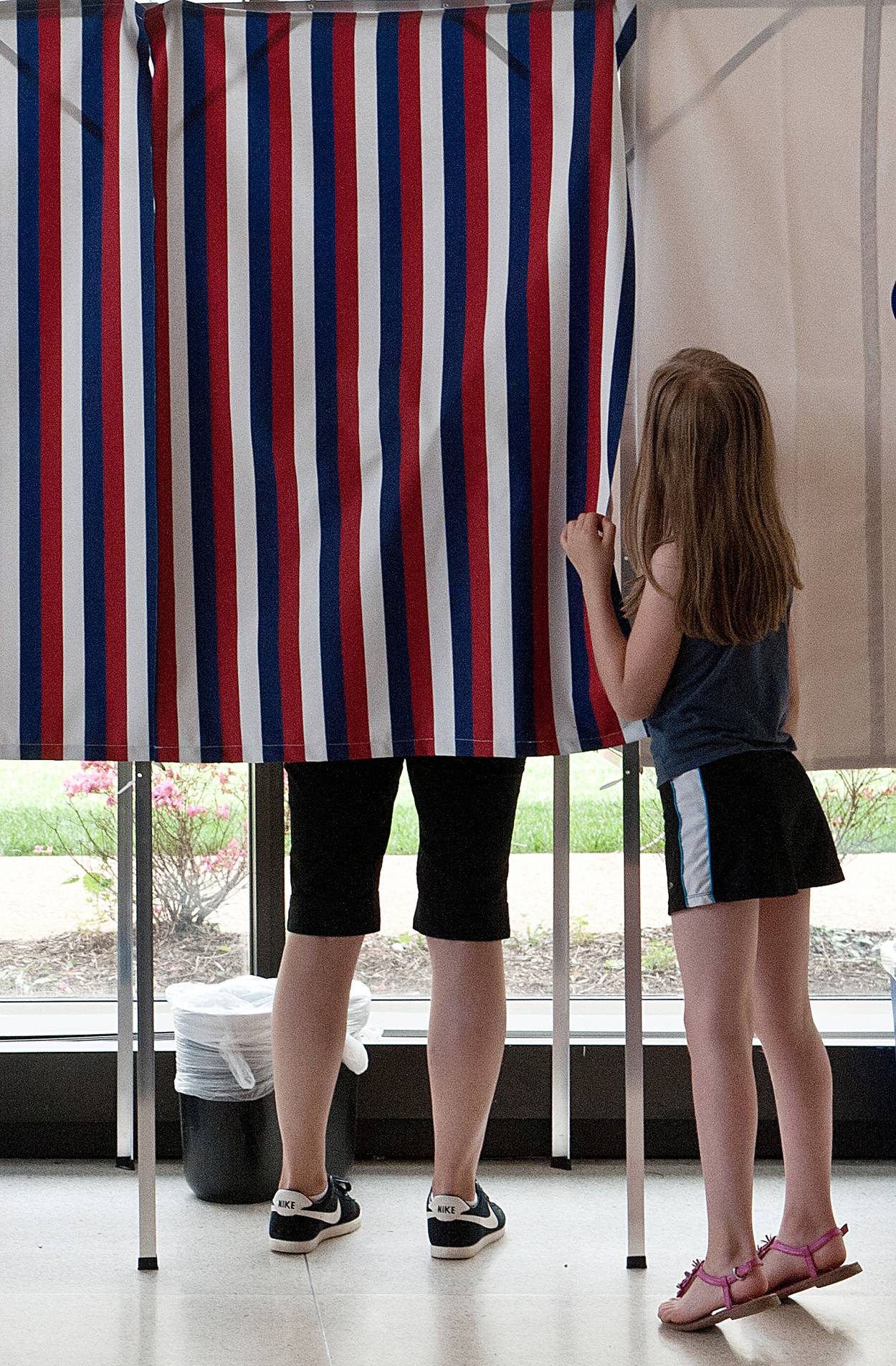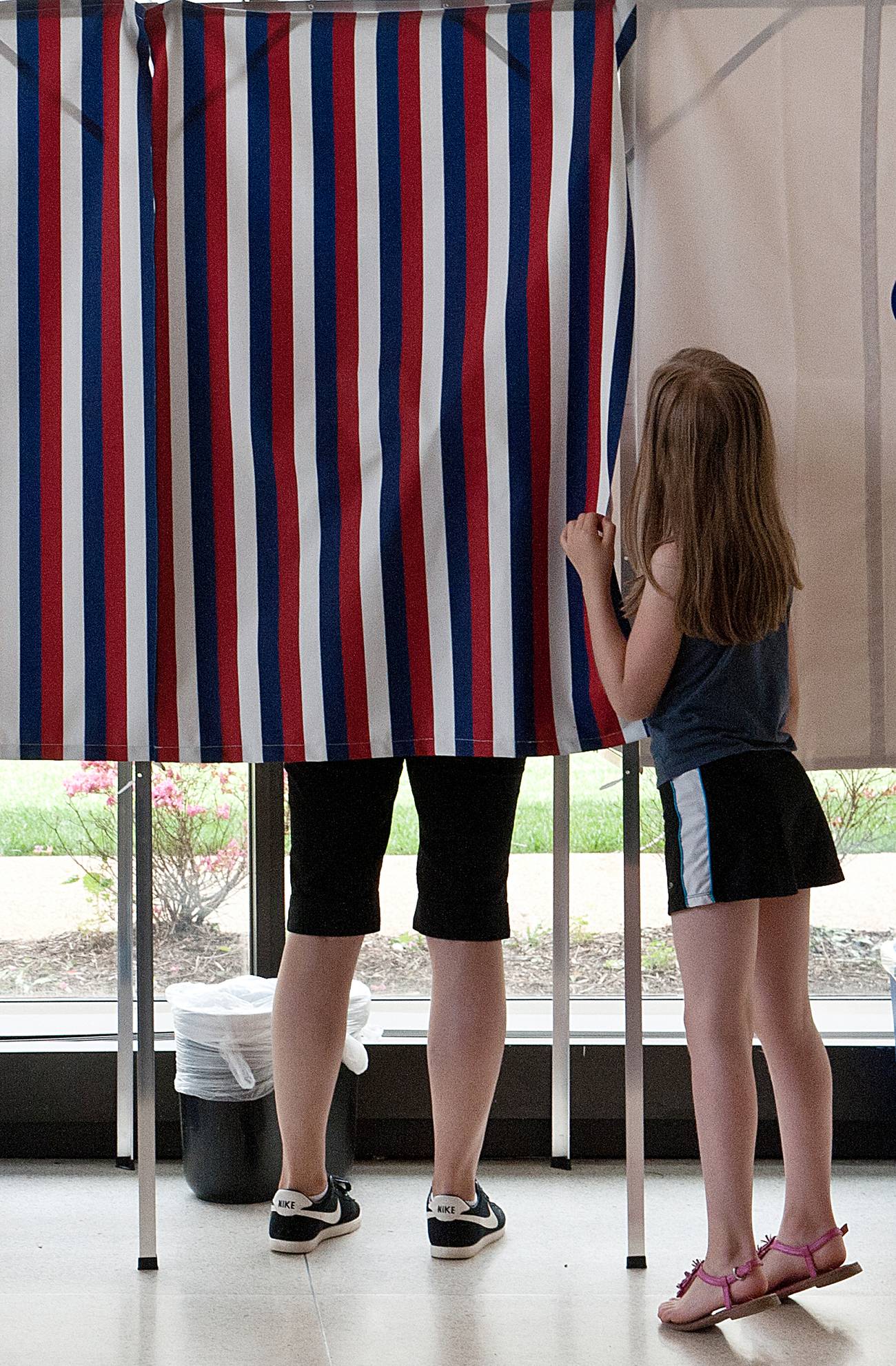Talking About the Election With Your Kids
What are your values, and how will you explain them to your offspring?




On Election Day in 2016, my kids and I made “glass ceiling cookies.” (When I was a kid, we called them stained-glass cookies.) You make a basic rollout cookie dough, stamp it into circles or hearts with a hole in the middle, and fill the hole with crushed hard candies smashed with a rolling pin by your extremely excited and cackling offspring. Self-satisfied like a total dimwit, I congratulated myself on my pedagogical cleverness in tying the breaking of the glass ceiling to the preelection lessons I’d taught the kids about democracy, the evolution of a country overcoming hundreds of years of sexism and misogyny, and the power of the vote.
As a family, we sat down to watch the early election returns come in.
And just before the kids went to bed, we threw the cookies, uneaten, into the trash. I haven’t made stained-glass cookies since.
But I’ve voted. I vote in every election, large and small. Throughout my kids’ lives, they’ve come with—at first in a BabyBjorn, then in a stroller, then on their own two feet. I am a fan of bribery: My little magpies liked collecting different “I Voted” stickers; when they got too old for stickers to be sufficient enticement, I took them from the polling place to the ice cream shop. For every election, I wore my uterus skirt, reflecting one of the issues I care deeply about: women’s reproductive rights, privacy, and health. Sometimes I paired the skirt (did I mention that it has a pocket? It has a pocket!) with my Bella Abzug T-shirt from the Jewish Women’s Archive; sometimes I wore my Notorious RBG sweatshirt. (May her memory be a blessing.)
Josie is now 18 and voting in her first presidential election. She’s living in New Haven (note my extremely subtle brag about where she got into college) and her absentee ballot never arrived. So she’s coming home to vote—thankfully she’s just a Metro North ride away, and we’ve all had COVID-19, so in-person voting feels less risky. I’ve already printed out a voting meme for her and Maxie, because I’m not a regular mom, I’m a cool mom.
Seriously, though: Teaching kids, from an early age, about the power of the ballot is important. (So is teaching them to cope when their/your candidate loses, alas.) I’ve written a lot in Tablet about teaching kids your values, encouraging them to ponder systemic racial inequities, and helping them learn in a nonboring way about the Jewish traditions of political activism and tikkun olam.
Fortunately, these lessons (well, except the one about losing graciously) aren’t hard to impart. Because from an early age, kids are developmentally obsessed with fairness and justice. Furthermore, you have a civic duty to talk to the next generation(s) about the hard-won right for everyone to vote.
The Center for Information and Research on Civic Learning and Engagement at Tufts University studies the importance of teaching kids about voting. One of their recent studies found that “students who had not received encouragement to vote from teachers in high school were more than twice as likely to agree with the statement ‘Voting is a waste of time’ as those who had been encouraged.” Among kids whose teachers talked about voting, 26% agreed that voting is vital; among kids whose teachers didn’t talk about it, only 12% agreed.
Honestly, both these numbers are still pretty lousy. (And I am shocked, shocked that white kids are way more likely to learn about voting in school! More than two-thirds of white students say they were encouraged to vote in high school, while only half of Black students got the same message.)
But schools in general aren’t doing the heavy lifting of civic education they once did. During the wave of Jewish immigration at the turn of the last century, Lower East Side public schools viewed creating good American citizens as part of their duty. Wealthier German Jews were determined to turn poor Eastern European greenhorns into less of a cultural embarrassment and poured money into settlement houses and civic projects designed to educate the clueless newcomers in how to be American. Today, there are Jewish organizations still doing the important work begun by the Hebrew Immigrant Aid Society in helping newcomers adapt, defending their rights, and advocating on behalf of refugees and asylum seekers (thanks, HIAS!), but what with many civic organizations’ understandable current focus on kids ripped away from their parents at the border, disparities in health care, and violence against Black people, we parents need to work extra hard and step into the breach of teaching our kids how voting can help others. Kids who understand voting are more likely to talk to friends about politics, advocate for the changes they believe in, volunteer on campaigns, pay attention to elections, participate in other modes of civic engagement, and grow up to vote themselves.
To instill the values of collective action and voting, you and your kids and grandkids can read fabulous picture books like Click Clack Moo: Cows That Type and Duck for President by Doreen Cronin; Brave Girl: Clara and the Shirtwaist Makers’ Strike of 1909 by Michelle Markel; Grace for President by Kelly DiPucchio; Hard Work, But It’s Worth It by Bethany Hegedus; Vote! by Eileen Christelow; and Voice of Freedom by Carole Boston Weatherford.
For slightly older kids, the ADL has a great minisite on talking about voting with kids. “Voting is an act of expressing your opinion,” it begins. It’s “a fundamental way that we let government know what we need, what issues are important to us, how we feel about those issues and what we want government to do. When people don’t vote, or when the majority of people do not vote, the will of the people is not expressed and therefore cannot be implemented.” The site points out while some folks feel that their one vote doesn’t matter, there have been a bunch of elections at all levels of government that illustrate just how vital every vote is. In a state House election in New Mexico four years ago, the winner was decided by two votes (out of 14,000)! And if, like my family, you live somewhere where your presidential vote doesn’t make much difference, local elections still do matter, and modeling good voting conduct—researching candidates, talking about your choices—is still essential parenting practice.
It’s also important to know how hard women and people of color fought to get the vote in the first place. The 15th Amendment gave Black men the vote in 1870, but some states did everything they could, from literacy tests and intimidation to deception, to prevent them from ever reaching the polls. It wasn’t until the passage of the Voting Rights Act of 1965, not that long ago, that Black people’s votes were actually protected. And today, all too many states are making it as hard as possible for Black citizens to vote by closing polling places, making oblique threats, and limiting the number of voting machines. White women got the vote in 1920, but again, Black women didn’t experience their full voting rights until 1965. The ADL has a handy outline of various voter suppression tactics for you and your spawn to peruse. Again: Children enjoy being outraged by injustice. Use this power for good. The self-same fury at getting the smaller half of the giant monster cookie can be deployed in a wider fight for fairness and equity.
It can be fun to discuss the tricks of political advertising—how do political ads use black-and-white and color images, music, voice-overs, and quotes from candidates to convey a message. Point your older kid toward the nonpartisan site factcheck.org if they’re repeating conspiracy theories or misinformation. (It might be helpful for you, too.)
Most important, you have to walk the walk when it comes to teaching kids about democratic values. Talk about giving tzedakah to the causes that matter to you, and why. Make kids research and choose their own organizations to give to from their allowance. Make sure they know if you’re planning to offer rides to polling places for elderly folk (windows down, masks on!) and/or act as a (nonthreatening, please!) poll watcher. You can take kids to marches and protests (outdoors, masked, and socially distanced—there have been COVID-19 outbreaks connected to indoor activities and unmasked, close-quarters outdoor rallies, but not to the massive numbers of masked outdoor protests.) Do not sputter about moving to Canada if your candidate loses unless you are actually moving to Canada, which you are not. When you catastrophize like that, not only do you scare kids needlessly that you’re going to rip them away from their friends after they’ve already been dealing with the stresses of COVID-19, but you also teach kids that your word is meaningless. Older kids can join you in writing postcards to voters, encouraging folks to get to the polls.
Finally, don’t teach kids to give up when they suffer a defeat. Yes, we threw out cookies in 2016, and I let my kids see me cry. Grieving and being furious are reasonable responses to shocking and terrible things. But I also tried to make sure they saw me double down on my efforts to make a better world. We switched shuls to be involved in a more activist community. And we talked about all the good stuff that happened (as far as we’re concerned; you may disagree) in the midterm elections: As the ADL put it, “The 2018 midterm elections broke records and barriers in terms of race, religion, gender, ethnicity, sexual orientation and other aspects of identity. The House of Representatives (116th Congress) was the most diverse class in history.” Two Native American women and two Muslim women were elected to Congress for the first time ever. A bunch of cities and states that had never elected a Black person or a woman to local office did so for the first time ever. We have a Black female candidate on the vice presidential ballot. (And her family’s nickname for her is Mamaleh! I’m Marjorie Ingall, and I approve this message.)
We have a lot of work to do. There is a ton of injustice out there. But we also have to be hopeful. There’s really no other way to raise kids.
Marjorie Ingall is a former columnist for Tablet, the author of Mamaleh Knows Best, and a frequent contributor to the New York Times Book Review.